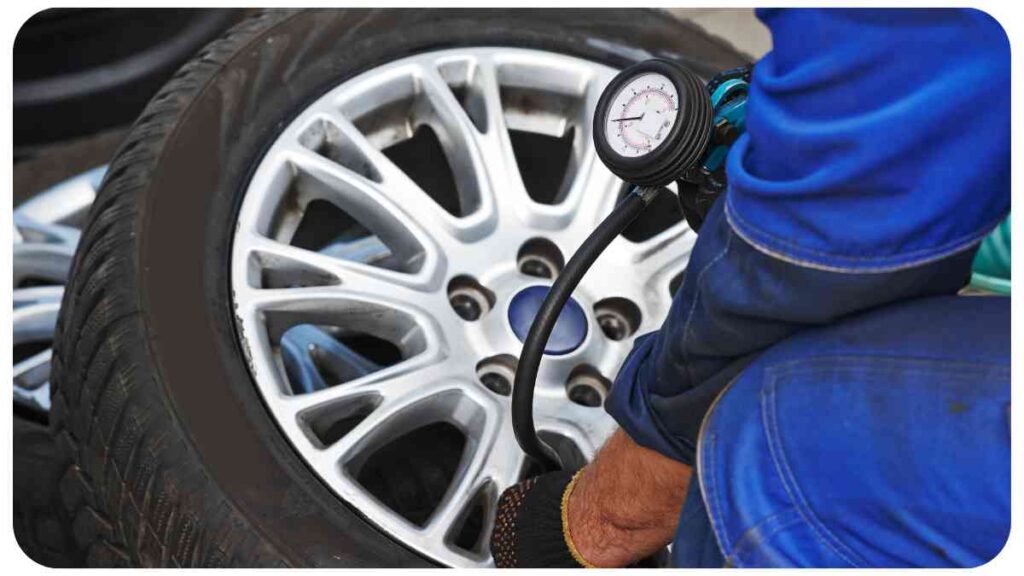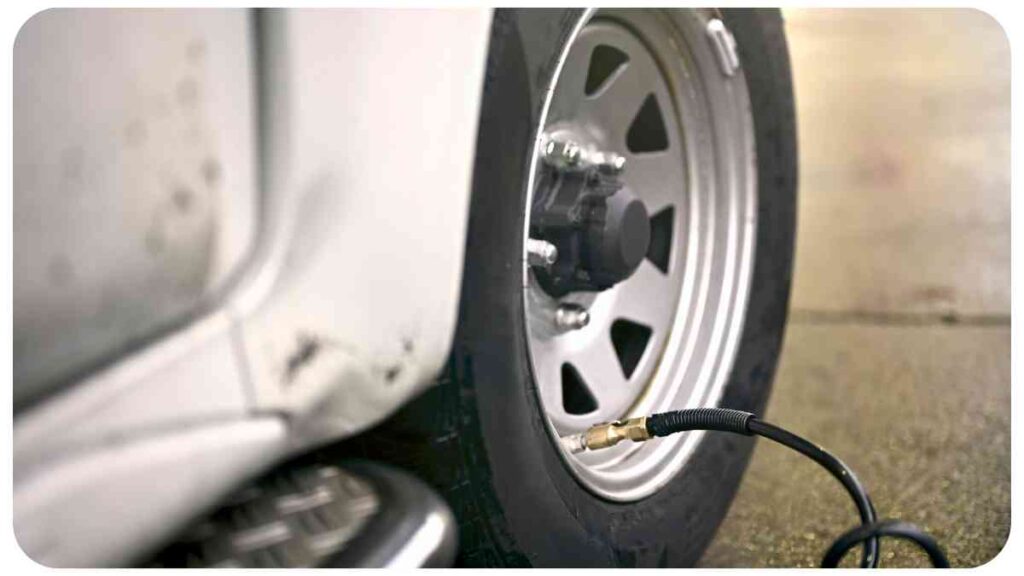Welcome to this comprehensive guide on understanding and managing the tire pressure of your all-terrain vehicle (ATV). As an ATV enthusiast with years of experience, I know how crucial it is to maintain optimal tire pressure for both performance and safety.
In this article, we will cover various aspects related to ATV tire pressure, including the importance of proper pressure, factors to consider before adjustment, ideal pressure for different riding conditions, how to measure and adjust tire pressure, common mistakes to avoid, the benefits of maintaining optimal pressure, tips for extending tire lifespan, and frequently asked questions. So let’s dive in and explore the world of ATV tire pressure together!
| Takeaways |
| Find the best tire pressure for your ATV based on various factors such as terrain and load capacity. |
| Regularly check and adjust your ATV’s tire pressure for optimal performance and safety. |
| Overinflated tires can lead to a stiff ride, reduced traction, and increased vulnerability to punctures. |
| Underinflated tires can result in poor handling, reduced fuel efficiency, and an uncomfortable ride. |
| Different terrains require different tire pressures for optimal performance, so adjust accordingly. |
The Importance of Proper ATV Tire Pressure
Understanding the significance of maintaining the correct tire pressure is essential for every ATV rider. Proper tire pressure ensures optimal handling, traction, and stability, enhancing your overall riding experience.
Inadequate inflation can result in poor maneuverability, reduced grip, and increased risks of accidents. On the other hand, overinflated tires can lead to a stiff and uncomfortable ride, reduced contact with the terrain, and potential tire damage. By keeping your ATV tires properly inflated, you will enjoy better control, improved fuel efficiency, and prolonged tire life.
Exploring different terrains with your ATV? Don’t let mud ruin your off-road adventures. Learn what you need to know about off-road driving in mud and conquer the challenges with confidence.
Factors to Consider Before Adjusting Tire Pressure

Before adjusting your ATV’s tire pressure, you need to consider a few factors that influence the ideal pressure. These factors include the manufacturer’s recommendations, the weight of the ATV, the type of terrain you ride on, and your riding style.
The manufacturer’s guidelines often provide a baseline pressure, but adjustments may be necessary based on these other factors. For example, if you carry heavy loads or frequently ride on rough terrains, you might need to increase the tire pressure slightly. Conversely, if you mainly ride on soft surfaces, a lower tire pressure might be more suitable. Keep in mind the importance of striking a balance between stability and comfort for the best riding experience.
Proper tire rotation is essential for maintaining optimal performance and longevity of your off-road vehicle. Learn how to properly rotate tires on an off-road vehicle with our detailed guide on tire rotation 101. Ensure even wear and get the most out of your tires during your off-road adventures.
Ideal Tire Pressure for Different Riding Conditions
Determining the ideal tire pressure for various riding conditions is crucial for optimizing performance and safety. The table below provides recommended tire pressure levels for different terrains:
| Terrain | Front Tire Pressure (psi) | Rear Tire Pressure (psi) |
| Hard-packed trails | 5-7 | 5-7 |
| Sand dunes | 2-4 | 2-4 |
| Mud | 3-5 | 3-5 |
| Rocks | 6-8 | 6-8 |
| Gravel | 4-6 | 4-6 |
Adjusting your tire pressure according to the terrain you plan to ride on will ensure better traction, stability, and control. Remember to fine-tune the pressure based on your ATV’s weight, as heavier loads may require slightly higher inflation.
When it comes to off-road driving, understanding how to navigate rocks, sand, and other terrains is crucial. Discover essential tips and techniques for off-road driving on different terrains to ensure a thrilling and safe adventure.
How to Measure and Adjust ATV Tire Pressure
Accurate measurement and adjustment of ATV tire pressure are essential for maintaining optimal performance. To measure the pressure, you’ll need a tire pressure gauge. Refer to the table below for a list of necessary tools:
| Tools | Purpose |
| Tire pressure gauge | Measure tire pressure |
| Air compressor or pump | Inflate or deflate tires |
| Valve stem tool or cap remover | Access the valve stem for changes |
| Tread depth gauge | Monitor tire wear |
Start by removing the valve stem cap and attach the tire pressure gauge to the valve stem. Press down firmly to ensure a proper seal, and note the reading provided by the gauge. If you find that the pressure is too low or high, you can adjust it using an air compressor or pump.
Add air if the pressure is low and release some air if it’s too high. Keep checking the pressure until you achieve the recommended levels for your specific riding conditions.
Common Mistakes to Avoid When Adjusting Tire Pressure

While it’s important to adjust your ATV’s tire pressure for optimal performance, it’s equally crucial to avoid common mistakes that can lead to problems. Here are some mistakes to watch out for and their consequences:
| Mistake | Consequences |
| Neglecting regular pressure checks | Uneven tire wear, decreased performance, and safety risks |
| Inconsistent pressure between front and rear | Poor handling, reduced stability, and potential accidents |
| Overinflating tires | Stiff ride, decreased traction, increased vulnerability |
| Underinflating tires | Reduced handling, lower fuel efficiency, potential punctures |
By being mindful of these mistakes, you can ensure that your ATV’s tire pressure remains at the optimal level for safety and performance.
The Benefits of Maintaining Optimal Tire Pressure
Maintaining the optimal tire pressure for your ATV offers various benefits that contribute to a better riding experience and prolonged tire lifespan. Here are some key advantages:
- Enhanced Performance: With the right tire pressure, you’ll experience improved handling, responsiveness, and traction. Your ATV will maneuver more smoothly, allowing you to navigate challenging terrains with confidence.
- Increased Safety: Properly inflated tires provide better stability and control, reducing the chances of accidents caused by poor handling or loss of grip. Additionally, maintaining optimal tire pressure minimizes the risk of blowouts or tire failures.
- Fuel Efficiency: Well-inflated tires reduce rolling resistance, resulting in improved fuel efficiency. By maximizing fuel economy, you can enjoy longer rides without the need for frequent refueling.
- Extended Tire Lifespan: Adequate tire pressure ensures even wear and prevents premature tire degradation. This will extend the lifespan of your ATV tires, saving you from the hassle and expense of frequent replacements.
- Consistent Performance: By regularly monitoring and adjusting tire pressure, you’ll maintain consistent performance across different riding conditions. This allows you to enjoy a comfortable and stable ride throughout your ATV adventures.
Remember, regularly checking and maintaining tire pressure is a small effort that yields significant rewards when it comes to the performance, safety, and longevity of your ATV tires.
Looking for ways to upgrade your Jeep for off-roading? Check out our list of the top 10 must-have off-road modifications for your Jeep and take your off-road experience to the next level.
Tips for Extending the Lifespan of ATV Tires
As an experienced ATV rider, I’ve learned a few tips and tricks to maximize the lifespan of ATV tires. Here are some valuable insights:
- Proper Storage: When your ATV is not in use, store it in a cool, dry place away from direct sunlight. This helps prevent tire damage and degradation.
- Rotate Tires: Regularly rotate your ATV tires to ensure even wear. This can be done according to the manufacturer’s recommendations or after a certain number of riding hours.
- Avoid Overloading: Excessive weight can strain the tires, leading to increased wear and reduced performance. Always adhere to the ATV’s weight limits and avoid carrying more than recommended.
- Inspect for Damage: Regularly inspect your tires for any signs of wear, cuts, or punctures. Promptly address any issues to prevent further damage and ensure optimal performance.
- Appropriate Cleaning: After riding in muddy or sandy conditions, clean your tires thoroughly to remove debris that can cause wear and tear over time.
Frequently Asked Questions about ATV Tire Pressure
Here are some commonly asked questions related to ATV tire pressure and their corresponding answers:
| Question | Answer |
| What happens if I ride my ATV with low tire pressure? | Low tire pressure can decrease traction, result in poor handling, and potentially cause tire damage or a blowout. |
| Is it okay to use the same tire pressure for all terrains? | No, different terrains require different tire pressures for optimal performance. Refer to the table in section 4 for recommended pressures. |
| How often should I check my ATV tire pressure? | It’s recommended to check your ATV tire pressure before every ride or at least once a month. |
| Can I use a standard tire pressure gauge for ATV tires? | Yes, a standard tire pressure gauge works fine for measuring ATV tire pressure. |
| What is the maximum or minimum tire pressure I can use? | Always refer to your ATV manufacturer’s guidelines for the recommended range of tire pressure. Exceeding the limits can be dangerous. |
Remember, if you have any specific concerns or uncertainties regarding ATV tire pressure, it’s always best to consult your ATV manufacturer or a professional for guidance.
Want to give your off-road truck a unique look? Get expert tips and tricks for customizing your vehicle in our comprehensive guide on customizing your off-road truck. Stand out on the trails with a customized ride that reflects your style.
Conclusion
Understanding and managing your ATV’s tire pressure is a crucial aspect of maintaining performance, safety, and longevity. By following the guidelines outlined in this comprehensive guide, you can optimize your ATV’s handling, traction, and overall riding experience. Remember to consider various factors such as terrain, load, and riding style when adjusting tire pressure.
Regularly measure and adjust tire pressure using a reliable pressure gauge, taking care to avoid common mistakes that can lead to poor performance or tire damage. By maintaining optimal tire pressure, you’ll experience enhanced control, improved fuel efficiency, and extended tire lifespan. Make use of the practical tips shared in this article to maximize the longevity of your ATV tires.
Safe riding and enjoy the exhilarating adventures with your ATV!
Further Reading
Here are some additional resources that you may find helpful for further information on ATV tire pressure:
- Fodsports: Best Tire Pressure for ATV
- This blog post provides detailed insights into finding the best tire pressure for your ATV based on different factors, including terrain and load capacity.
- Vehicolic: ATV Tire Pressure
- Vehicolic offers a comprehensive guide on ATV tire pressure, covering topics such as proper inflation, tire pressure maintenance, and the impact on ATV performance.
- Valor Offroad: Tire Pressure 101
- Explore this informative blog post from Valor Offroad, which delves into the basics of tire pressure for off-road vehicles, including ATVs. Learn about the importance of optimal tire pressure and tips for maintaining it.
FAQs
Here are some commonly asked questions about ATV tire pressure:
Q: How often should I check my ATV’s tire pressure?
A: It is recommended to check your ATV’s tire pressure before every ride or at least once a month to ensure optimal performance.
Q: Can I use a regular car tire pressure gauge for my ATV tires?
A: Yes, a standard tire pressure gauge can be used for measuring ATV tire pressure. Just make sure it is compatible with the valve stems on your ATV tires.
Q: What are the consequences of riding with overinflated ATV tires?
A: Overinflated ATV tires can lead to a stiff ride, reduced traction, and increased vulnerability to punctures due to decreased surface contact with the terrain.
Q: How do I know if my ATV tires are underinflated?
A: Signs of underinflated ATV tires include poor handling, reduced fuel efficiency, and a bumpy or uncomfortable ride. Additionally, visible sidewall bulges indicate significant underinflation.
Q: Can I use the same tire pressure for all types of terrain?
A: No, different terrains require different tire pressures for optimal performance. Refer to manufacturer recommendations or consult guides for the recommended pressures based on the terrain you will be riding on.

Hi there! I’m Hellen James, and I’m the author of Unified Off-roads. I’ve been driving off-road for more than ten years, and I’ve had a lot of fun in that time—and a few not-so-great experiences too. But I’ve always wanted to help other people get started off-roading, so I decided to start this blog to share my knowledge with others.


